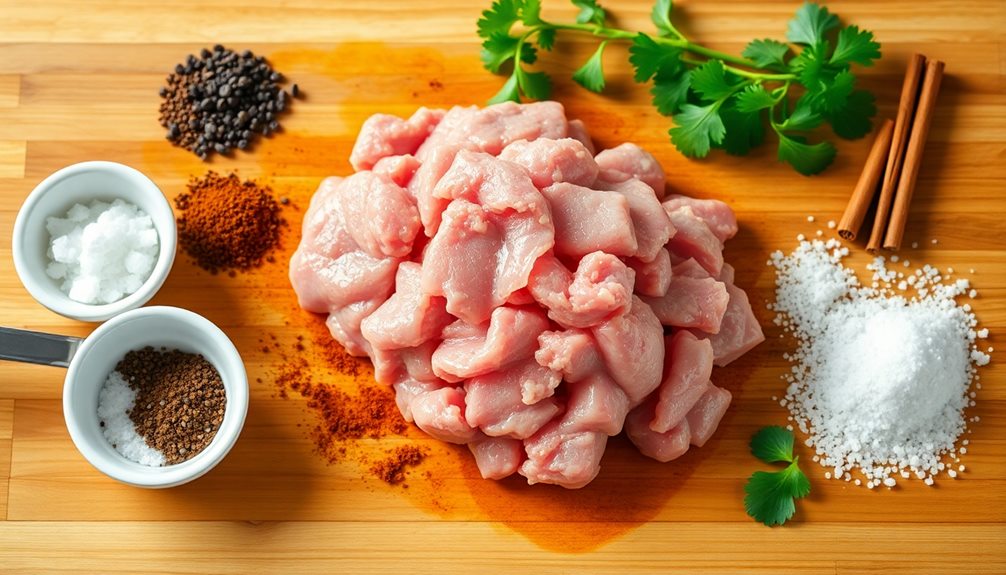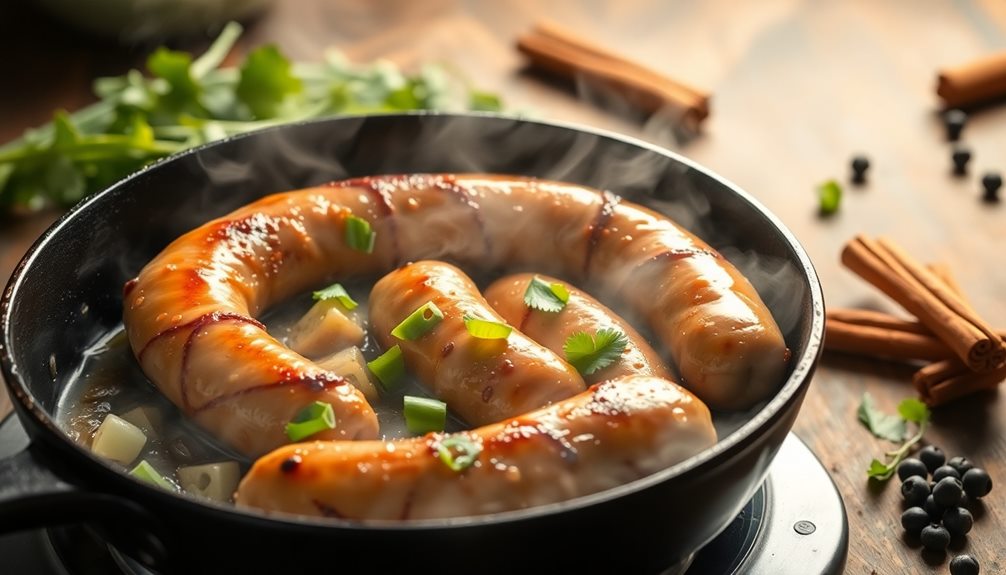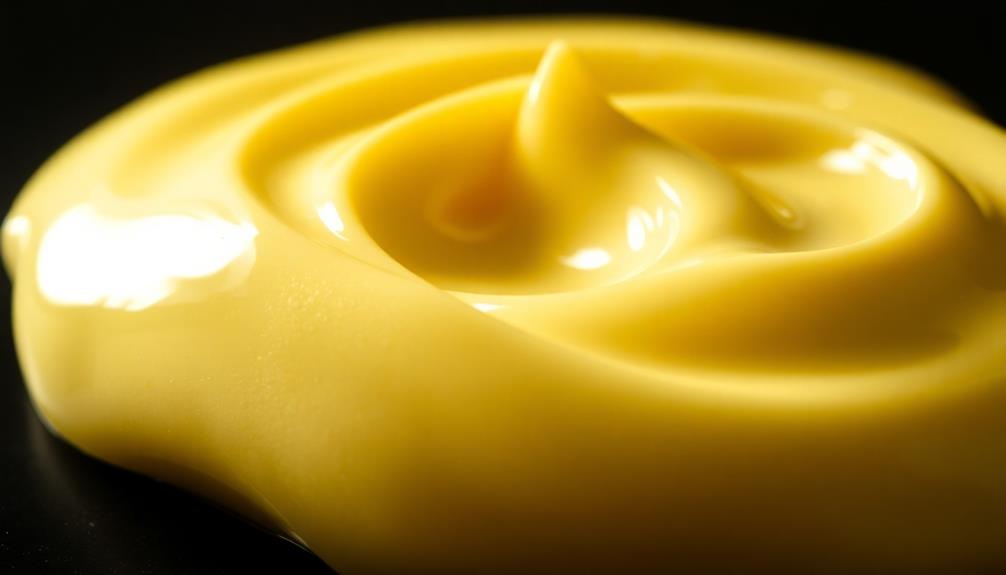Chả Quế, or Vietnamese cinnamon pork sausage, is a delicious treat you'll love! This flavorful dish has roots in Vietnamese celebrations and brings families together. To make it, you'll combine ground pork with spices like cinnamon, garlic, and fish sauce. After mixing, let it chill to blend flavors, then stuff it into casings. Cook it over medium heat until perfectly golden. Enjoy it in a banh mi sandwich or alongside rice for a tasty meal! This dish not only tastes great but also creates special moments with friends and family that you won't want to miss. Keep exploring to discover more about this culinary delight!
Key Takeaways
- Vietnamese cinnamon pork sausage, or "gio lua," is traditionally made with ground pork, cinnamon, garlic, and fish sauce.
- The dish is significant in Vietnamese culture, often served during special occasions and family gatherings.
- It features a unique sweet and savory flavor profile, distinguishing it from other types of sausages.
- Gio lua can be enjoyed in various dishes, including banh mi sandwiches or with rice.
- Cooking and sharing this dish fosters community connections and creates memorable experiences among family and friends.
History
Vietnamese cinnamon pork sausage, known as "gio lua," has a rich history rooted in the culinary traditions of Vietnam. This tasty treat dates back centuries and is often enjoyed during special occasions and family gatherings.
Imagine a time when families would gather to prepare the sausage, mixing fresh pork with fragrant spices, including cinnamon. It wasn't just about the food; it was a way to bond and share stories.
In Vietnam, gio lua became popular because it was easy to transport and could be eaten cold or hot. You might find it served at celebrations or as a tasty snack during a picnic. The unique flavor of cinnamon sets it apart from other sausages, making it a beloved dish among many.
As the years went by, gio lua traveled beyond Vietnam's borders, delighting people all over the world.
Today, you can find it in Vietnamese restaurants and homes, where it's loved for its delicious taste and cultural significance.
Cooking Steps
Creating your own delicious cinnamon pork sausage is a rewarding experience that brings flavors to life. First, gather all your ingredients: ground pork, cinnamon, garlic, sugar, and fish sauce. You'll also need some fresh herbs like green onions and cilantro for that extra zing!
Start by mixing the ground pork with the spices and herbs in a large bowl. Use your hands to squish everything together until it's well combined. It's fun to feel the mixture!
Next, let it sit for about 30 minutes in the fridge. This helps the flavors blend and makes it tastier.
Once it’s ready, shape the mixture into small sausages or patties. You can make them whatever size you like! If you’re making sausage shapes, roll the mixture into small cylinders. If you prefer patties, flatten the mixture into small disks. Whichever shape you choose, be sure to refrigerate the mixture for at least 30 minutes before cooking to help it hold together. With these simple steps, you’ll have the perfect meatball recipe that’s versatile and delicious.
Now, heat up a skillet over medium heat and add a little oil. Cook the sausages for about 4-5 minutes on each side, or until they're nice and golden brown.
When they're cooked, let them rest for a minute before serving. Enjoy your homemade cinnamon pork sausage on a bun or with rice. You'll be amazed at how great it tastes! Happy cooking!
Step 1. Prepare Pork and Spices

To prepare the pork and spices for your Vietnamese cinnamon pork sausage, start by selecting high-quality ground pork, ideally with a balance of fat for moisture and flavor. This will make your sausage juicy and delicious!
Next, gather your spices. You'll need cinnamon, sugar, salt, black pepper, and fish sauce. Each spice adds a unique flavor to your sausage, so make sure you measure them carefully. If you want to spice things up a bit, consider adding crushed garlic or chopped shallots. They'll contribute extra layers of taste that everyone will love.
Now, let's get everything ready! Place the ground pork in a large bowl, and make sure it's nice and soft. You can use your hands to break it apart a little, which helps when you mix in the spices later.
Don't forget to keep your workspace clean. Wash your hands and any utensils you use to prevent any mess.
Once you've got your pork and spices prepped, you'll be all set for the next step! Exciting, right? You're on your way to making a tasty treat that your family and friends will enjoy!
Step 2. Mix Spices Into Pork

Now it's time to mix those spices into the pork. Grab your bowl of ground pork and add in the spices you prepared earlier. Make sure you have your cinnamon, garlic, pepper, and sugar ready. It's like throwing a little flavor party in your bowl!
Using your hands, gently mix everything together. You want to combine the spices evenly throughout the meat, so don't be shy—dive right in! As you mix, feel the texture of the pork and the spices coming together. It's important to make sure every bite will burst with flavor.
Keep mixing until you can't see any dry spots. This should take about a minute or two. If you want, you can also use a spoon, but your hands will help you get that perfect blend.
Once everything's mixed, take a moment to smell your mixture. Doesn't it smell amazing? You're almost there!
Now, let it sit for a little while, so the flavors can mingle even more. This step is crucial for making your chả quế extra tasty. Get ready for the next exciting part of our sausage-making adventure!
Step 3. Stuff Sausage Casings Carefully

With your seasoned pork ready, it's time to stuff the sausage casings carefully. First, grab your casings and rinse them well under cold water. This helps remove any salt and makes them easier to work with.
Next, place one end of the casing on the stuffing tube of your sausage maker, allowing a little to hang off the edge.
Now, you're ready to fill the casing! Start pushing the seasoned pork mixture into the tube, making sure to fill it evenly. Don't overstuff, though! Leave a little space at the end so you can twist and tie them later. As you fill, watch for air bubbles; if you see any, gently poke them with a pin to let the air escape.
Once you've filled the casing, tie a knot at the open end. Then, use kitchen twine to twist and separate the sausages into links, about six inches long.
Keep going until you've used all your mixture. Remember, it's all about taking your time and being gentle. You're creating something delicious, so enjoy the process!
Step 4. Refrigerate Before Cooking

Refrigerating the stuffed sausage links is an essential step that enhances their flavor and texture. Once you've filled the casings, it's time to pop them in the fridge! This waiting period lets all those delicious spices mingle together, making the sausage taste even better when you finally cook it.
Plus, chilling the sausages helps them hold their shape, so they don't fall apart while cooking. You should leave the sausage links in the refrigerator for at least 30 minutes, but if you can wait a little longer, that's even better! Just imagine the amazing smells wafting through your kitchen when you cook them.
If you've got time, consider chilling them overnight. This way, the flavors will intensify, and you'll be left with a mouthwatering treat.
While the sausages are chilling, you can clean up your cooking area, or even prepare some side dishes to enjoy with your delicious cinnamon pork sausage. Just remember, the more time you give them to chill, the tastier they'll be!
Step 5. Cook Sausages Over Medium Heat

Cooking your Vietnamese cinnamon pork sausages over medium heat is key to achieving that perfect balance of juicy interior and nicely browned exterior.
Start by preheating your skillet or grill. You want it warm, but not too hot, so the sausages cook evenly.
Once your cooking surface is ready, place the sausages on it. You'll hear a satisfying sizzle—that's a good sign! Let them cook for about 6 to 8 minutes on one side. Resist the urge to poke or flip them too soon; patience is important.
After they're nicely browned, turn them over gently. Continue cooking for another 6 to 8 minutes. This way, the sausages will be fully cooked and bursting with flavor.
Keep an eye on them, and if you notice they're browning too quickly, lower the heat a bit.
When they're done, use a meat thermometer to check the internal temperature. It should read 160°F (71°C).
Once they're cooked, let them rest for a few minutes before serving. This helps the juices settle, making every bite delicious.
Enjoy your tasty Vietnamese cinnamon pork sausages!
Final Thoughts
Vietnamese cinnamon pork sausage offers a delightful blend of flavors that can elevate any meal. You'll love how the sweet and savory notes come together, making every bite a tasty adventure.
Whether you're grilling them up for a barbecue or cooking them in a pan, these sausages always bring a smile to your face.
As you try making this dish, remember that it's not just about the ingredients. It's also about the joy of cooking and sharing with friends and family.
You can serve these sausages in so many ways, like in a banh mi sandwich or with a side of rice. The possibilities are endless, and that's what makes it so exciting!
Don't forget to experiment with spices and herbs, too. You might discover a new twist that you absolutely love!
Cooking can be a fun journey, and with Vietnamese cinnamon pork sausage, you're sure to create wonderful memories around the dinner table.
So, roll up your sleeves, grab your ingredients, and let your culinary creativity shine. As you savor each bite, you'll be reminded of how food can bring people together and create lasting connections.
Enjoy every moment!
Frequently Asked Questions
What Are the Main Ingredients in Chả Quế?
When you explore the main ingredients, you'll typically find ground pork, garlic, sugar, fish sauce, and various spices. These elements blend together to create a deliciously savory and aromatic dish that's sure to satisfy.
How Is Chả Quế Traditionally Served?
Traditionally, you serve it sliced, accompanied by fresh herbs, pickled vegetables, and rice or noodles. You might also enjoy it wrapped in lettuce leaves, enhancing the flavors and providing a refreshing crunch.
Can Chả Quế Be Frozen for Later Use?
Yes, you can freeze chả quế for later use. Just ensure it's well-wrapped to avoid freezer burn. When you're ready to enjoy it, thaw it in the fridge overnight before reheating.
What Are Common Variations of Chả Quế?
You'll find several common variations that highlight different flavors and ingredients. These might include spicy versions, those with added herbs, or even vegetarian adaptations, each bringing a unique twist to the traditional recipe you enjoy.
Is Chả Quế Gluten-Free?
You'll find that many traditional sausages can be gluten-free, depending on the ingredients used. Always check the label or ask about the recipe to ensure it doesn't contain any gluten-containing additives or fillers.










